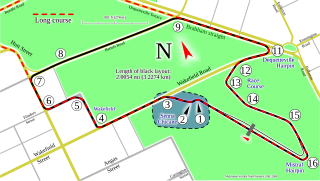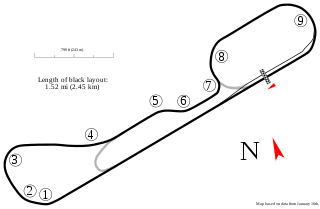
The 1985 Australian Grand Prix was a Formula One motor race held on the Adelaide Street Circuit in Adelaide on 3 November 1985. The sixteenth and final race of the 1985 Formula One World Championship, it was the 50th running of the Australian Grand Prix and the first to be held on the streets of Adelaide on a layout specifically designed for the debut of the World Championship in Australia. The race was held over 82 laps of the 3.780 km (2.362 mi) circuit for a total race distance of 310 kilometres. The race was won by Keke Rosberg driving a Williams-Honda; this was the final win for Rosberg and the last by a Finnish driver until Mika Häkkinen won the 1997 European Grand Prix.

The Adelaide Street Circuit is a temporary street circuit in the East Parklands adjacent to the Adelaide central business district in South Australia, Australia.

The Phillip Island Grand Prix Circuit is a motor racing circuit located near Ventnor, on Phillip Island, Victoria, Australia. The current circuit was first used in 1956.

Mallala Motor Sport Park is a 2.601 km (1.616 mi) bitumen motor racing circuit near the town of Mallala in South Australia, 55 km north of the state capital, Adelaide.

The Adelaide International Raceway is a permanent circuit owned by Australian Motorsport Club Limited under the auspices of the Bob Jane Corporation. The circuit is located 26 km (16 mi) north of Adelaide in South Australia on Port Wakefield Road at Virginia, and is adjacent to Adelaide's premier car racing Dirt track racing venue, Speedway City. AIR is owned by the Bob Jane Corporation and run by the Australian Motorsport Club Ltd.

The Longford Circuit was a temporary motor racing course laid out on public roads at Longford, 23-kilometre (14 mi) south-west of Launceston in Tasmania, Australia. It was located on the northern edges of the town and its 7.242 km (4.500 mi) lap passed under a railway line viaduct, crossed the South Esk River via the wooden Kings Bridge, turned hard right at the doorstep of the Longford Hotel, passed over the railway line using a level crossing and traversed the South Esk again via another wooden structure, the Long Bridge.
The 1928 Australian Grand Prix was a motor race held on the Phillip Island road circuit, on Phillip Island, Victoria, Australia on 31 March 1928. Although now known as the first Australian Grand Prix, the race was actually staged as the 100 Miles Road Race and it did not assume the Australian Grand Prix title until some years later. It was organised by the Victorian Light Car Club.
The 1954 Australian Grand Prix was a motor race held at the Southport Road Circuit near Southport in Queensland, Australia on 7 November 1954. The race was held over 27 laps of the 5.7 mile circuit, a total distance of 153.9 miles (247.6 km). It was the nineteenth Australian Grand Prix and the second to be held in Queensland. With no suitable permanent circuit available, a course was mapped out on roads in sparsely settled coastal land 2.5 km south west of Southport, and just to the north of later circuits, Surfers Paradise Raceway and the Surfers Paradise Street Circuit. The Grand Prix race meeting was organised by the Queensland Motor Sporting Club and the Toowoomba Auto Club in conjunction with the Southport Rotary Club. The race, which was open to Racing and Stripped Sports Cars, had 28 starters.

Dundrod Circuit is a motorsport street circuit used for the Ulster Trophy for Formula One and Formula Two cars from 1950 to 1953, the RAC Tourist Trophy for sports cars between 1950 and 1955, and for the motorcycle Ulster Grand Prix from 1953 onwards. It is situated near the village of Dundrod in Lisburn, Northern Ireland. The nearby Clady Circuit also in County Antrim was used for the Ulster Grand Prix between (1922–1952) before moving to the Dundrod Circuit.

The 1938 Australian Grand Prix was a motor race held at the Mount Panorama Circuit near Bathurst in New South Wales, Australia on 18 April 1938. It was staged over 40 laps of the six kilometre circuit for a total distance of 241 kilometres. The race, which was organised by the Light Car Club of New South Wales, attracted 38 entries, 30 of which started the race. 33,000 people paid for admission to the circuit on race day.
The 1951 Australian Grand Prix was a Formula Libre motor race held at a street circuit in Narrogin, Western Australia on 5 March 1951. The race was held over 24 laps of the 7.1-kilometre (4.4 mi) circuit for a race distance of 170 kilometres (110 mi).
The 1950 Australian Grand Prix was a motor race held at the Nuriootpa Road Circuit in South Australia on 2 January 1950. It was organised by the Sporting Car Club of South Australia, promoted by the Barossa Valley Vintage Festival Association and staged over 34 laps of the 4.8-kilometre circuit for a race distance of 163 kilometres. The race, which is recognized by the Confederation of Australian Motor Sport as the fifteenth Australian Grand Prix, was a Formula Libre race.
The 1948 Australian Grand Prix was a motor race held at the Point Cook Aerodrome, a Royal Australian Air Force base at Point Cook, just outside Melbourne in Victoria, Australia on Australia Day, 26 January 1948. It was staged over 42 laps of a 3.85 kilometre circuit utilizing the runways and service roads of the base. The total race distance was 162 kilometres. The race was organised by the Light Car Club of Australia and was sanctioned by the Australian Automobile Association.
The 1937 Australian Grand Prix is a name which has been applied retrospectively to the 1936 South Australian Centenary Grand Prix, a motor race held on the Port Elliot-Victor Harbor road circuit in South Australia on Boxing Day, 26 December 1936.
The 1935 Australian Grand Prix was a motor race held at the Phillip Island circuit in Victoria, Australia on 1 April 1935. The 200 mile race was organised by the Light Car Club of Australia and was open to cars with an engine capacity not exceeding 2000cc. It was the eighth Australian Grand Prix and the last to be staged at the Phillip Island circuit.

The Lobethal Circuit was a motor racing course centred on the South Australian town of Lobethal in the Mount Lofty Ranges, 22 miles from the state capital, Adelaide. It was utilized for four race meetings from 1937 to 1948, hosting a number of major races including the 1939 Australian Grand Prix. Today the roads of the circuit make up a part of the Tour Down Under international bicycle race.

The 1939 Australian Stock Car Road Championship was a motor race staged at the Lobethal Circuit in South Australia on 2 January 1939. It was contested on a handicap basis over six laps of the 8.6 mile course, a total distance of 50 miles. The handicap format saw the slowest cars starting first and the fastest cars starting last.

The 1948 South Australian 100 was a motor race staged at the Lobethal Circuit in South Australia on 1 January 1948. It was contested as a handicap race with the slowest cars starting first and the fastest cars last. The race was staged over 12 laps, a total distance of 105 miles. It was open to cars of any engine size.

The 1938 South Australian Grand Prix was a motor race staged at the Lobethal Circuit in South Australia, Australia on 3 January 1938. It was held over 12 laps, a total distance of 100 miles. The race, which was the second South Australian Grand Prix, was contested on a handicap basis with the first car starting 30 minutes before the "Scratch" car.

The 1940 South Australian Hundred was a motor race staged at the Lobethal Circuit in South Australia on 1 January 1940. It was held over 12 laps of the 8¾ mile course, a total distance of 100 miles. The race was contested on a handicap basis with the slowest cars starting first and the fastest last. The "limit man", RS Uffindell, commenced the race 23 minutes before the "virtual scratch man", Alf Barrett.












